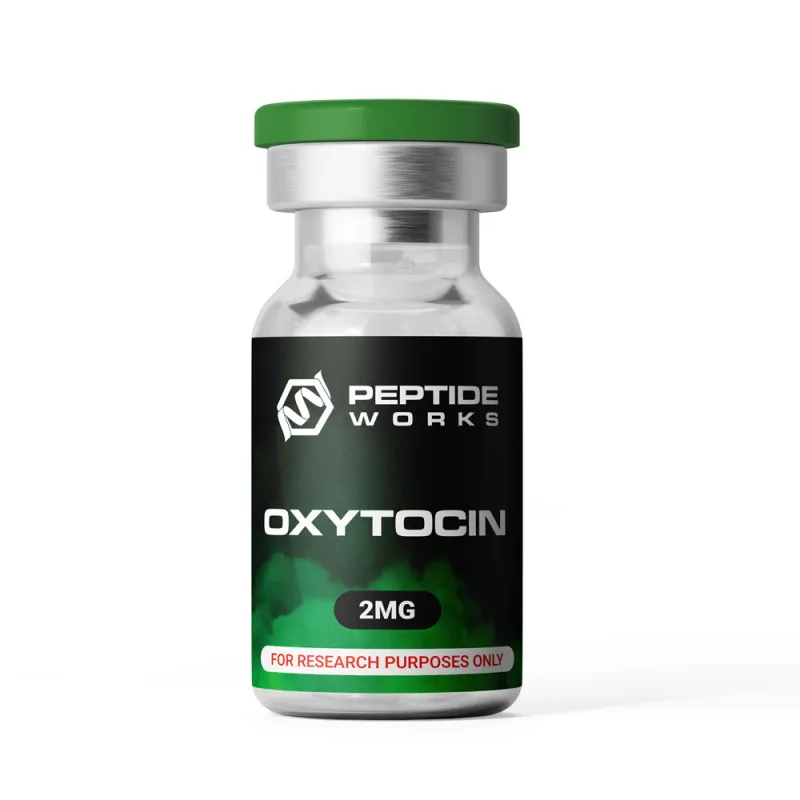
PROMO!
First order? Get 10% OFF with this code: 1storder
Written by

Among the many messengers that guide behavior, one stands out for its role in bonding, reproduction, and stress control. It is often called the Love Hormone. Scientists have linked this signal with feelings of trust, attachment, and emotional closeness, making it a central subject in modern research.
The peptide most often connected with this term is oxytocin, though interest is also growing in related peptides such as PT-141 and Kisspeptin. Together, these molecules help researchers examine how social bonding, reproductive health, and emotional resilience are shaped by chemical signaling in the brain. These studies often examine oxytocin levels to understand how changes in this peptide influence behavior.
This article will examine how the Love Hormone works, the role of its receptors, and what current studies reveal about its wider influence. Understanding its broader influence begins with how oxytocin is made and how it works inside the brain.
Discover Oxytocin from Peptide Works, the Love Hormone peptide studied for its role in bonding, emotional balance, and stress pathways.

Oxytocin is made in the hypothalamus, a part of the brain that controls many body signals. From there, it travels through the paraventricular nucleus (PVN) and reaches other parts of the brain, including the ventral tegmental area and the nucleus accumbens, both known as reward pathways tied to dopamine release.
When oxytocin binds to receptors in these areas, it can shift activity in powerful ways. For example, it reduces signaling in the amygdala, which is the region that processes fear and stress. This action supports calm, trust, and stronger social bonds.
Through these pathways, the Love Hormone helps guide bonding and emotional connection. Research shows it also shapes sensitivity to social cues, which may explain why oxytocin is a major focus in behavioral studies exploring social cognition, social recognition, and even context-dependent aggressive behavior.
To understand these effects more deeply, it is important to look at the receptors that allow oxytocin to carry out its role.
Oxytocin receptors, often called OXTR, are the points in the brain where the Love Hormone attaches and sends its signals. Studies in species such as prairie voles show that these receptors in areas like the nucleus accumbens are linked to strong pair bonds. When the receptors are blocked in controlled settings, bonding behaviors often weaken or disappear.
Newer research shows the story is more complex. In some cases, bonding still occurs even without oxytocin receptors, which suggests oxytocin works together with other systems. This means receptors help strengthen social attachment but may not be the only factor involved.
Scientists also study variations in the OXTR gene, which appear connected to traits such as empathy and social sensitivity. These findings show why oxytocin receptors are central in research on bonding and social behavior. Genetic variations open another important layer of study, giving insight into how oxytocin signaling may differ across cases, particularly in conditions such as low oxytocin levels, which may influence bonding and romantic attachment.

Variations in the OXTR gene, which codes for oxytocin receptors, are often associated with differences in social behavior. Some studies link specific gene patterns to traits such as empathy, trust, and emotional sensitivity. These findings indicate that oxytocin’s influence involves not only where the hormone acts in the brain but also how its receptors are shaped at the genetic level.
These systems form part of the broader oxytocin system, which plays a important role in emotional processing, mental health, and social support networks. Among those peptides, Kisspeptin has gained particular attention for its central role in reproductive biology.
Among those peptides, Kisspeptin has gained particular attention for its central role in reproductive biology.
Kisspeptin is a central regulator in reproduction. By binding to the KISS1R receptor, it stimulates gonadotropin-releasing hormone (GnRH) neurons in the hypothalamus. By activating the HPG axis, Kisspeptin signals trigger the release of LH and FSH. Both hormones are critical messengers in reproductive biology, guiding puberty, fertility, and gamete growth.
Neurons that produce Kisspeptin are found in the arcuate nucleus (ARC) and the anteroventral periventricular nucleus (AVPV). These neurons respond to sex steroids and help regulate hormone feedback, making Kisspeptin a priority in fertility and reproductive health research.
Alongside this, scientists are investigating PT-141, another peptide linked to reproduction. Unlike Kisspeptin, PT-141 works on melanocortin receptors rather than the HPG axis.
Early results suggest it may influence sexual function and arousal, showing how multiple peptides are being studied for their effects on both reproductive and behavioral signaling. Building on this, PT-141 has been studied more directly for its influence on sexual function.
Explore Kisspeptin from Peptide Works, a key peptide in reproductive signaling that regulates hormone release and fertility-related pathways.

PT-141, also called Bremelanotide, works in a different way than the Love Hormone, oxytocin. While oxytocin acts through bonding pathways and the HPG axis, PT-141 targets melanocortin receptors (MC3R and MC4R) in the brain. These receptors are part of neural circuits that control sexual arousal and sexual behavior.
Animal studies show that PT-141 can stimulate neurons linked with sexual function. In research models, it produced erectile effects, while clinical trials found dose-related erectile activity in men and higher desire scores in premenopausal women. By acting through the central nervous system, PT-141 offers a different pathway from the Love Hormone, showing how multiple peptides are being explored in reproductive and behavioral studies.
While PT-141 highlights one alternate route, oxytocin itself continues to attract attention for its influence on emotional resilience and stress regulation.
Check out PT-141 from Peptide Works, a peptide investigated for its unique action on melanocortin receptors linked to arousal and sexual function.
The Love Hormone, oxytocin, has drawn attention for its important role in stress control. Studies indicate that it can reduce activity in the amygdala, the part of the brain that handles fear and threat perception. With this effect, oxytocin may encourage calmer states and ease anxiety-like reactions in controlled research settings.
It is also linked to the hypothalamic-pituitary-adrenal (HPA) axis, the system responsible for releasing cortisol and other stress hormones. Evidence suggests oxytocin can influence this pathway, helping the body maintain balance under strain. These pathways highlight the key role of oxytocin in emotional resilience and stress regulation, particularly in conditions tied to mental health.
Looking forward, researchers continue to examine oxytocin and related peptides to understand what the future of Love Hormone research might reveal.
Research on the Love Hormone, oxytocin, continues to reveal how it shapes trust, bonding, and stress response. Alongside it, peptides such as PT-141 and Kisspeptin are expanding knowledge in reproductive and behavioral science. Together, these findings point toward new directions in peptide research and the many ways signaling molecules influence health and behavior.
At Peptide Works, we provide high-quality peptides for laboratory use, supporting researchers worldwide in uncovering what comes next.
All products discussed are supplied for research purposes only and are not intended for human use.
[1] Carter CS. Oxytocin and love: Myths, metaphors and mysteries. Compr Psychoneuroendocrinol. 2021 Dec 27;9:100107.
[2] Bosch OJ, Young LJ. Oxytocin and Social Relationships: From Attachment to Bond Disruption. Curr Top Behav Neurosci. 2018;35:97-117.
[3] Walum H, Lichtenstein P, Neiderhiser JM, Reiss D, et al. Variation in the oxytocin receptor gene is associated with pair-bonding and social behavior. Biol Psychiatry. 2012 Mar 1;71(5):419-26.
[4] Blanks AM, Shmygol A, Thornton S. Regulation of oxytocin receptors and oxytocin receptor signaling. Semin Reprod Med. 2007 Jan;25(1):52-9.
[5] Peled-Avron L, Abu-Akel A, Shamay-Tsoory S. Exogenous effects of oxytocin in five psychiatric disorders: a systematic review, meta-analyses and a personalized approach through the lens of the social salience hypothesis. Neurosci Biobehav Rev. 2020 Jul;114:70-95.
ALL CONTENT AND PRODUCT INFORMATION AVAILABLE ON THIS WEBSITE IS FOR EDUCATIONAL PURPOSES ONLY.
DISCLAIMER: These products are intended solely as a research chemical only. This classification allows for their use only for research development and laboratory studies. The information available on our Peptide Works website: https://peptide-works.com/ is provided for educational purposes only. These products are not for human or animal use or consumption in any manner. Handling of these products should be limited to suitably qualified professionals. They are not to be classified as a drug, food, cosmetic, or medicinal product and must not be mislabelled or used as such.
Peptide Works
Related Articles

How effective could Orexin Addiction Therapy be?
Have you ever wondered why some people find it so hard to stop addictive habits, even when they truly want

Can NAD Therapy Improve Cognitive Performance?
NAD Therapy is gaining attention in research for its possible role in brain health. NAD+ (nicotinamide adenine dinucleotide) is a

Enhancing Energy with NAD+ Supplements
Energy is the driving force behind focus, movement, and recovery. When cells have less energy to work with, the body